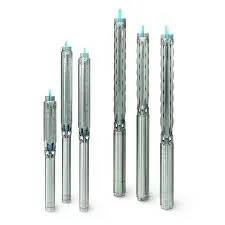Nov . 06, 2024 18:30 Back to list
High Capacity Submersible Pumps for Efficient Water Transfer Solutions
High Flow Submersible Pumps An Essential Solution for Efficient Water Management
In the realm of water management and industrial applications, high flow submersible pumps have emerged as a critical solution for a multitude of tasks. These versatile machines are designed to perform efficiently in various environments, ranging from construction sites to municipal sewage systems and agricultural applications. By delving into the features, applications, and advantages of high flow submersible pumps, one can appreciate their significance in modern water management.
Understanding High Flow Submersible Pumps
A high flow submersible pump is engineered to operate underwater and is typically utilized for draining, dewatering, and transferring large volumes of water quickly and efficiently. Unlike traditional pumps that may need to draw water from the surface, submersible pumps are submerged in the fluid they are meant to pump, allowing them to push the water to the surface through a discharge pipe. The design of these pumps includes a hermetically sealed motor that prevents water from entering and damaging the electrical components, ensuring reliable performance in challenging conditions.
Key Features
1. High Flow Rate As the name suggests, high flow submersible pumps are capable of moving large quantities of fluid in a short amount of time. Most models are designed to handle flow rates ranging from several hundred gallons per minute (GPM) to thousands, making them suitable for demanding applications.
2. Durability Constructed from robust materials such as stainless steel and heavy-duty thermoplastics, high flow submersible pumps can withstand the harsh conditions often encountered in industrial and construction sites.
3. Versatility These pumps can handle a variety of liquids, including clean water, sewage, sludge, and even abrasive materials, depending on their design and material construction.
high flow submersible pump

5. Automated Controls Many high flow submersible pumps come equipped with automatic controls and sensors that enable remote operation, ensuring optimal performance without the need for constant monitoring.
Applications
High flow submersible pumps serve an array of applications across different sectors. In construction, they are indispensable for dewatering excavations and keeping job sites dry. In agriculture, these pumps are used for irrigation and managing water levels in fields, ensuring that crops receive adequate moisture. Moreover, municipal water treatment plants rely on these pumps for efficient sewage management and stormwater drainage, protecting urban environments from flooding.
Additionally, in mining operations, high flow submersible pumps are crucial for managing water used in extraction processes and for keeping mines dry, thereby enhancing safety and productivity. Their ability to handle abrasive materials also makes them suitable for handling wastewater and industrial effluents.
Advantages
The adoption of high flow submersible pumps brings numerous advantages. Firstly, their ability to operate submerged reduces the risk of cavitation and enables them to handle greater depths than surface pumps. Secondly, the high efficiency of these pumps translates into lower energy consumption, contributing to significant cost savings over time. Furthermore, the compact design of submersible pumps allows for easier transportation and installation, which is particularly beneficial in remote or temporary job sites.
Finally, the reliability of high flow submersible pumps often leads to decreased downtime and maintenance costs, as fewer breakdowns occur when these pumps are properly maintained. In industries where time is money, this reliability translates into substantial economic benefits.
Conclusion
High flow submersible pumps are invaluable tools in the management of water and fluid resources across various industries. Their efficient operation, durability, and versatility make them the go-to solution for challenges ranging from construction dewatering to sewage treatment. As technology continues to advance, the effectiveness and applications of high flow submersible pumps will likely expand, further solidifying their role as essential components in water management strategies. With their ability to deliver high performance in demanding conditions, these pumps are poised to remain indispensable in the quest for efficient and effective water management.
-
Submersible Water Pump: The Efficient 'Power Pioneer' of the Underwater World
NewsJul.01,2025
-
Submersible Pond Pump: The Hidden Guardian of Water Landscape Ecology
NewsJul.01,2025
-
Stainless Well Pump: A Reliable and Durable Pumping Main Force
NewsJul.01,2025
-
Stainless Steel Submersible Pump: An Efficient and Versatile Tool for Underwater Operations
NewsJul.01,2025
-
Deep Well Submersible Pump: An Efficient 'Sucker' of Groundwater Sources
NewsJul.01,2025
-
Deep Water Well Pump: An Efficient 'Sucker' of Groundwater Sources
NewsJul.01,2025
-
 Submersible Water Pump: The Efficient 'Power Pioneer' of the Underwater WorldIn the field of hydraulic equipment, the Submersible Water Pump has become the core equipment for underwater operations and water resource transportation due to its unique design and excellent performance.Detail
Submersible Water Pump: The Efficient 'Power Pioneer' of the Underwater WorldIn the field of hydraulic equipment, the Submersible Water Pump has become the core equipment for underwater operations and water resource transportation due to its unique design and excellent performance.Detail -
 Submersible Pond Pump: The Hidden Guardian of Water Landscape EcologyIn courtyard landscapes, ecological ponds, and even small-scale water conservancy projects, there is a silent yet indispensable equipment - the Submersible Pond Pump.Detail
Submersible Pond Pump: The Hidden Guardian of Water Landscape EcologyIn courtyard landscapes, ecological ponds, and even small-scale water conservancy projects, there is a silent yet indispensable equipment - the Submersible Pond Pump.Detail -
 Stainless Well Pump: A Reliable and Durable Pumping Main ForceIn the field of water resource transportation, Stainless Well Pump has become the core equipment for various pumping scenarios with its excellent performance and reliable quality.Detail
Stainless Well Pump: A Reliable and Durable Pumping Main ForceIn the field of water resource transportation, Stainless Well Pump has become the core equipment for various pumping scenarios with its excellent performance and reliable quality.Detail
